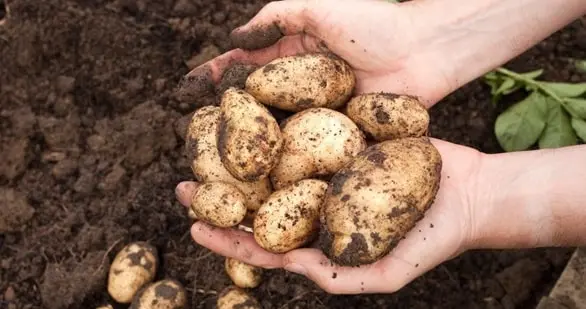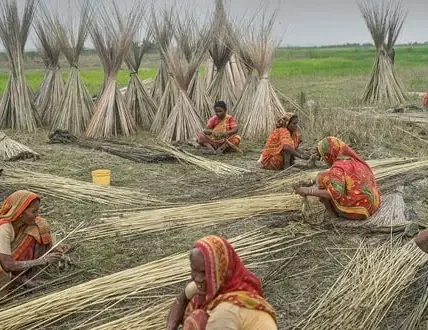Potatoes, a versatile and essential crop, play a crucial role in global agriculture and food security. As we move, instead, into 2025, it remains interesting to consider the top potato producers in the business with a more focused look on the countries that aid significantly in covering the world’s demand for this starchy staple. These countries range from Asia to Europe, North America to South Asia with mega-amounts of the potatoes grown exposing their prowess in agriculture. Let us then unwrap the top 10 biggest potato producing countries all across the globe for the year 2025.
1. China – 78,183,874 Metric Tons:
China dominates potato production. China produces 78,183,874 metric tons of potatoes, demonstrating its agricultural commitment. This vast production displays the nation’s dedication to local and global trade. China’s vast agricultural landscapes and effective farming technologies dominate the global potato market and also fruits & vegetables production. The nation’s extensive agricultural regions allow large-scale potato growing. Modern agricultural technology and methods enhance production and productivity in China. Beyond local demand, potatoes make China a global potato player. China can satisfy its demands and contribute to the global supply of this versatile and widely consumed crop by wisely managing resources and innovating.
2. India – 51,300,000 Metric Tons:
Potato production ranks second in India, a global food source. Excellent soils and diverse agroclimatic conditions make India ideal for potato growing, generating 51,300,000 metric tons. Indian potato agriculture develops owing to its diverse landscapes and good climate. The country’s ability to raise potatoes reflects its agricultural commitment. India’s potato production meets local need and makes it a worldwide powerhouse. India’s diverse and varied cuisine depends on potatoes. Many Indian cuisines include potatoes, making them bright and unique. Potatoes are employed in innovative Indian cuisine, demonstrating its importance.
3. Ukraine – 20,837,990 Metric Tons:
Ukraine produces 20,837,990 metric tons of potatoes, third worldwide. Ukraine produces potatoes worldwide due to its agricultural focus and environment. Ukraine’s third-largest producer status displays its agricultural devotion. The nation strategically grows potatoes because to its abundant natural resources and favorable environment. High output is a testament to Ukraine’s sustainable and creative farming practices, which have enhanced its agricultural environment. Ukraine takes pride in its agriculture, as seen by its high potato production. Ukraine’s agricultural innovations fulfill local needs and dominate the potato market. Ukrainian potatoes flourish in their ideal environment. Potato agriculture is efficient and fruitful because the nation uses its natural resources and modern agricultural methods. Ukraine produces a lot of potatoes owing to its dedication to agriculture, decent climate, and efforts to adopt sustainable farming methods.
4. Russia – 19,607,361 Metric Tons:
Russia produces 19,607,361 metric tons of potatoes, fourth worldwide. Russia’s abundant land and suitable climate boost the worldwide potato industry. Russia’s fourth-place potato production indicates its agricultural potential and efficient use of its wide fertile land. Russian potato farming may rule the globe owing to its fertile soil. The country’s capacity to exploit its vast land resources indicates its agricultural commitment. Climate helps Russia compete in potato sales. The country’s nice climate makes potato farming viable and profitable. Russia’s climatic advantage makes it a global agricultural powerhouse. Russia’s vast fertile area and agricultural conditions produce many potatoes. Russia meets domestic and global potato demand as a significant supplier.
5. United States – 18,789,970 Metric Tons:
The US produces 18,789,970 metric tons of potatoes, sixth globally. The nation’s commitment to agricultural excellence is driven by new farming technologies and a huge agricultural infrastructure. The U.S. satisfies global potato demand with innovative farming techniques. The country’s agricultural business employs cutting-edge technologies to increase production. This method meets local and global potato demand with high production. A vast U.S. agricultural infrastructure impacts the global potato market, along with technological improvements. The country’s cultivation, transport, and logistical networks make potato production and supply easy. This robust infrastructure helps the U.S. navigate the complex agricultural supply chain, ensuring a high crop output. Tech innovation and a robust agricultural framework work together in US potato production. The U.S. is a global potato powerhouse that can feed growing populations.
6. Germany – 11,715,100 Metric Tons:
Germany grows 11,715,100 metric tons of potatoes, sixth in the world. Germany’s dedication to sustainable agriculture and expertise with modern technologies is shown by this achievement. Germany’s agricultural environment values sustainability and ecological balance. The country’s potato production prioritizes quantity and environmental harmony, demonstrating its sustainable agriculture. Large potato output reflects Germany’s advanced agricultural skills. Technology helps German potato growers be more productive. This combination of modern and ancient agricultural practices offers Germany a global potato market edge. German potato farming combines heritage and innovation beyond production. National farmers focus meeting current requirements and ensuring agricultural sustainability. Germany’s innovative strategy makes it a global potato market leader that can adapt to shifting agricultural circumstances.
7. Bangladesh – 9,606,000 Metric Tons:
Bangladesh produces 9,606,000 metric tons of potatoes, sixth worldwide. People in Bangladesh depend on potatoes from their agricultural business. Bangladesh’s excellent potato output highlights agriculture’s economic importance. Potato cultivation and harvesting sustain Bangladesh’s economy and population. Bangladeshi cuisine depends on potatoes for food security and nutrition. Bangladesh relies on agriculture for food and income. Bangladesh is the seventh-largest potato producer, and its farmers endure difficult weather to harvest a huge crop.
8. France – 8,691,900 Metric Tons:
Sixth in potato production is France, noted for its gastronomy with 8,691,900 metric tons. Quality potato farming is an art form due to the country’s gourmet culture and agricultural heritage. French potatoes are grown to the highest standards. Potato growing in France is shaped by years of agricultural expertise. France produces plenty of potatoes, but the eighth-place ranking reflects quality. French potatoes are popular internationally for their texture, flavor, and flexibility and contribute to agricultural exports. Due to meticulous cultivation, good weather, and tradition, French potatoes are high-quality.
9. Poland – 7,848,600 Metric Tons:
Poland produces 7,848,600 metric tons of potatoes, eleventh worldwide. Sustainable cultivation and industrialization have made the nation a global potato leader. Forward-thinking Poland prioritizes environmental conservation and agricultural profitability. Polish farmers have increased potato yields using modern technology. Due to its commitment to sustainability and modernization, Poland leads global efforts to balance agricultural production with environmental responsibility. Polish ranking ninth emphasizes its significance to world potato supply. Agriculture is vital to local and global potato markets. Old expertise and contemporary technology help Poland produce 7,848,600 metric tons of potatoes.
10. Netherlands – 7,020,060 Metric Tons:
The Netherlands produces 7,020,060 metric tons of potatoes, seventh worldwide. Innovative agricultural methods and technology make the Netherlands a global leader in potato farming despite its small size. Potato farming in the Netherlands demonstrates agricultural innovation. Dutch farmers employ modern agricultural practices and technology to boost yield. This unique strategy has helped the Netherlands establish a robust potato industry despite its little geographical size. The Netherlands produced 7,020,060 metric tons of potatoes, proving traditional agricultural expertise works with contemporary technology. Automation, precision farming, and eco-friendly methods enhance potato productivity and quality nationwide. Dutch farmers’ expertise and focus on agricultural research and development make them a global potato leader. Potatoes are valued locally and internationally for their quality, taste, and versatility.
Conclusion:
As we tread on the agro landscape of 2025, these top 10 countries would be serving as strong pillars of food security for the entire globe. Actively consumed in these countries, potatoes act as staples that not only sustain populations but also emerge as major items of international trade and commerce. Understanding the dynamics of potato production underlines the interdependency of agriculture across nations and serves to spotlight the importance of such countries in meeting the growing global demand for this adaptable tuber.

Brandon is the cheif editor and writer at WorldUnfolds.com. With a passion for storytelling and a keen editorial eye, he crafts engaging content that captivates and enlightens readers worldwide.















